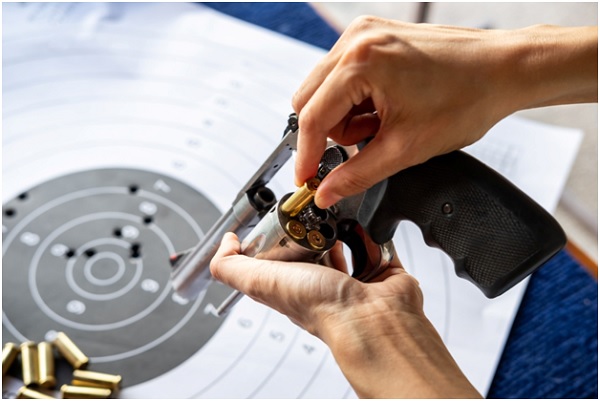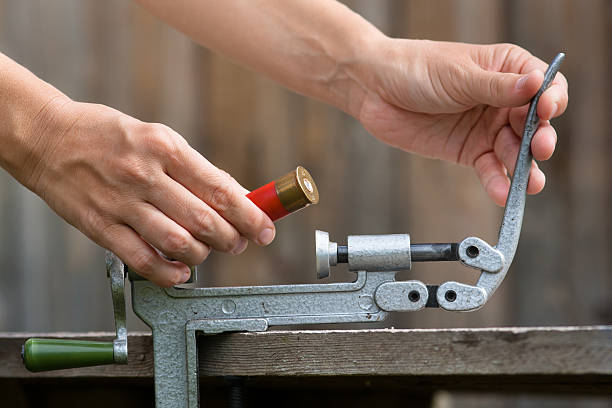
The Olympics’ biathlon competition will take place from February 5- 19.Biathlon combines two sports into one race – cross-country skiing and rifle marksmanship. The best of competition is determined by clock time with a penalty for each missed shot. Biathletes must balance speed on the ski course and on the range along with shooting accuracy. They shoot from both prone and standing positions in various sequences depending on the event. Each shooting stage involves 5 shots at 5 targets positioned 50 meters downrange. From the prone position, the target area is 4.5 cm (1.771 inches). From standing, the target is 11.5 cm (4.528 inches).
Optics are not allowed; only non-magnified diopter rear and globe front sights are permitted. For every target missed, the athlete is penalized. Depending on the event, the penalty can be one lap around a 150 m loop, or a one-minute penalty added to their time. The penalty loop is separate from the regular course.
The Winter Olympics biathlon uses the .22 LR cartridge only. The .22 LR rimfire cartridge was standardized for International Biathlon Union (IBU) competitions in 1978. Current rules require that the muzzle velocity not exceed 360 meters per second (1,181.1 feet per second). Bullets must weigh between 2.55 and 2.75 grams.
Athletes must carry their rifles at all times. The minimum rifle weight is 3.5 kg (7.716 pounds)without the magazine and ammunition. Biathlon rifles are usually equipped with straight-pull actions, integrated magazine carriers, and ergonomic stock designs suitable for both prone and standing shooting positions. One unique feature on a biathlon rifle is a pistol grip with an integrated thumb rest to isolate the movement of the trigger finger from the thumb, which tend to move together as a sympathetic reflex.
Competition Rounds and Reloading Supplies
Obviously, almost none of us compete at the Olympic level but other competitions can be just as demanding of equipment and ammo. The targets become more challenging, and rifles are specialized to the various competitions. Highly proficient shooters must bring equipment, ammo, and personal performance all together at the same time to achieve peak results. Where we fit in is with reloading supplies and equipment that have less “wiggle room” when it comes to reloading custom ammo.
Finding a good 200- and 300-yard load for your service rifle shouldn’t be an agonizing process. While firearms are generally accurate, they can be further maximized by loading ammo that is specific to them. With some studying and by controlling every step of the reloading process you will produce exceptionally reliable ammunition.
Practice makes “almost” perfect and that takes thousands of rounds. Reloading precision rounds not only improves your overall performance, but for those on a budget it allows you to practice as often as time allows.
Recommendation for Improving Your Precision Loading Process
Many highly accomplished shooters believe quality brass is the foundation of great ammo. Begin by inspecting every cartridge case and discarding those that are worn.
Most top shooters also anneal the brass. Annealing extends brass life and makes neck tension more consistent (important for accuracy). The process is heating the neck and shoulder of the case — but never the body and base. An effective and inexpensive method is using a torch to heat the cases only to the point of a dull red glow and then quenching in water. It’s important not to overheat the case. This might not be the perfect process, but it is better than nothing. Andhey, reloading is about trying different techniques to find what works best for you.
Sizing and trimming cases to length is essential for ammo to be functional. Stretching does occur but can be trimmed with a case trimmer. When primer pockets become stretched they are no longer reliable.
Weight sorting brass can be optional depending on the quality of brass used. When working with superior quality brass that comes from the same lot, it dramatically decreases the need to weight-sort.
We recommend full-length sizing when shooting fired brass for the first time in any rifle. Neck sizing with Lee’s Collet Dies generally provides increased accuracy because the spent cartridge becomes “fire formed” to your specific chamber. Neck sizing is only preferred when reloading cases that have been fired out of your rifle. Collet neck sizing results in cases lasting up to ten times longer without the need for trimming near as often, as when full-length sizing.
As you might guess, top shooters spend almost an excessive amount of time to achieve a precision powder charge. The number of high-caliber shooters using very high-end pharmaceutical grade scales is split at about 50-50 with those using more common high-grade powder scales. It’s worth noting that pharmaceutical grade scales (costing over $500) can achieve accuracy down to a single kernel of powder. It is also very time-consuming and not always worth the time, especially for practice rounds. This is why 50% use a less costly and faster scale.
Handloading provides a solid education in how ammunition works, ammunition pressure curves, bullet selection, and accuracy. When you load your own ammunition you will have consistency. Best yet, it’s an enjoyable pastime!
Titan Reloading is dedicated to helping novice and veteran shooting enthusiasts safely and properly reload their own ammunition every time. Let me hear about your ammo reloading tips and stories at mailto:dennis@titanreloading.com. Titan Reloading wants to be part of your reloading experience. You’ll find a constantly updated stream of insights and tips from our blogs, newsletters, help videos, and FAQs. For more information and/or to shop our online store please visit www.TitanReloading.com or contact Titan Reloading the Master Distributor of Lee Precision reloading equipment & supplies at 262.397.8819.

